lock CHEVROLET AVEO 2004 1.G User Guide
[x] Cancel search | Manufacturer: CHEVROLET, Model Year: 2004, Model line: AVEO, Model: CHEVROLET AVEO 2004 1.GPages: 334, PDF Size: 2.35 MB
Page 31 of 334
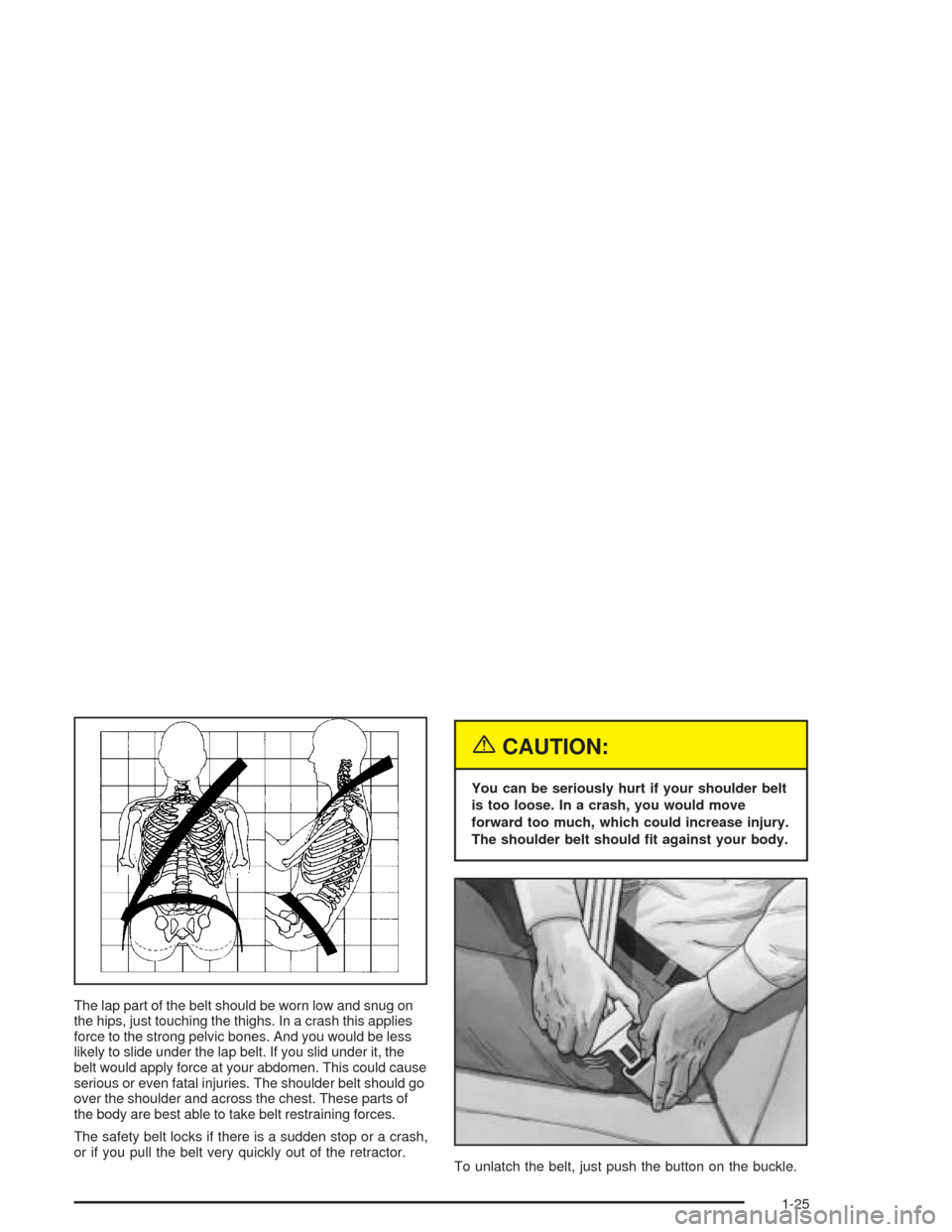
The lap part of the belt should be worn low and snug on
the hips, just touching the thighs. In a crash this applies
force to the strong pelvic bones. And you would be less
likely to slide under the lap belt. If you slid under it, the
belt would apply force at your abdomen. This could cause
serious or even fatal injuries. The shoulder belt should go
over the shoulder and across the chest. These parts of
the body are best able to take belt restraining forces.
The safety belt locks if there is a sudden stop or a crash,
or if you pull the belt very quickly out of the retractor.
{CAUTION:
You can be seriously hurt if your shoulder belt
is too loose. In a crash, you would move
forward too much, which could increase injury.
The shoulder belt should �t against your body.
To unlatch the belt, just push the button on the buckle.
1-25
Page 51 of 334
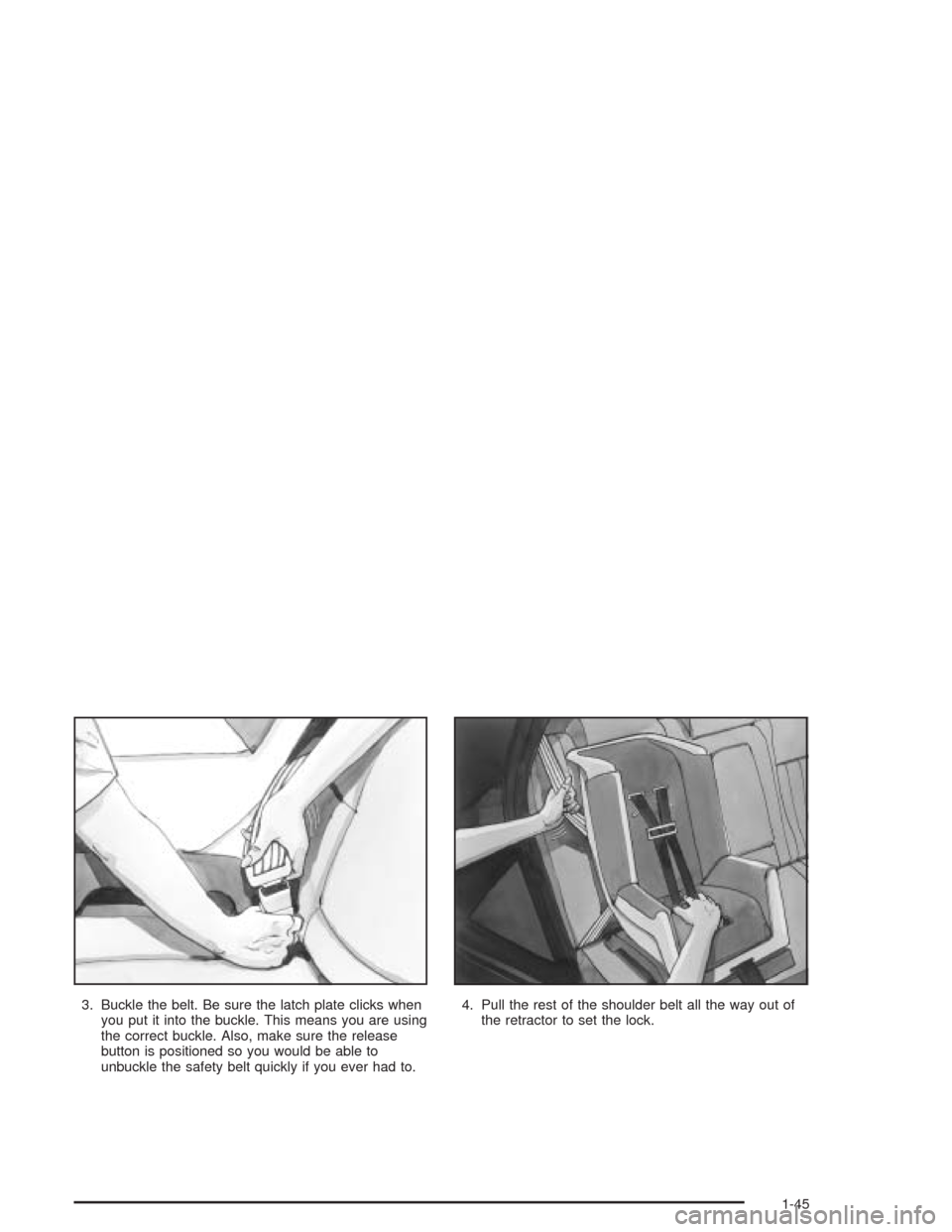
3. Buckle the belt. Be sure the latch plate clicks when
you put it into the buckle. This means you are using
the correct buckle. Also, make sure the release
button is positioned so you would be able to
unbuckle the safety belt quickly if you ever had to.4. Pull the rest of the shoulder belt all the way out of
the retractor to set the lock.
1-45
Page 54 of 334
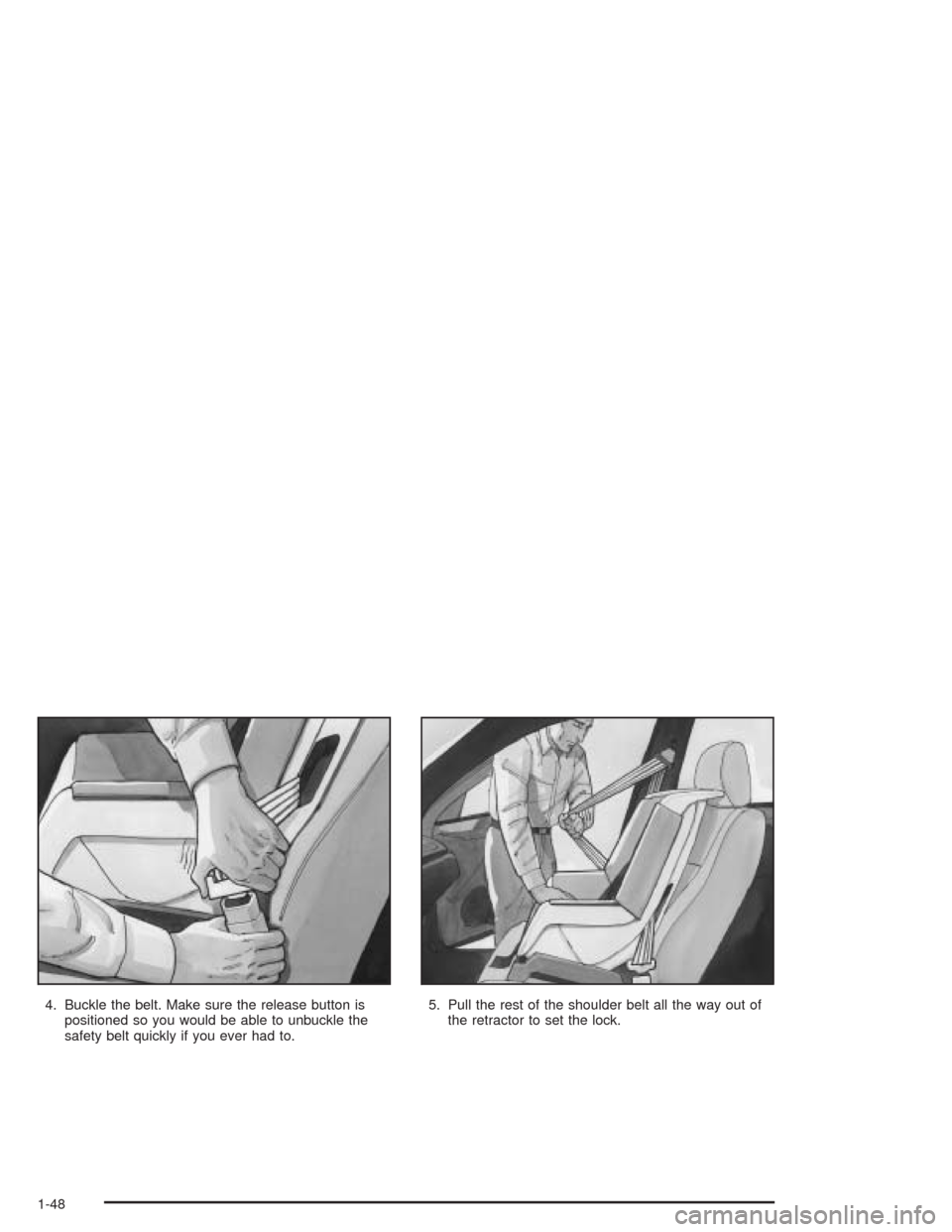
4. Buckle the belt. Make sure the release button is
positioned so you would be able to unbuckle the
safety belt quickly if you ever had to.5. Pull the rest of the shoulder belt all the way out of
the retractor to set the lock.
1-48
Page 60 of 334
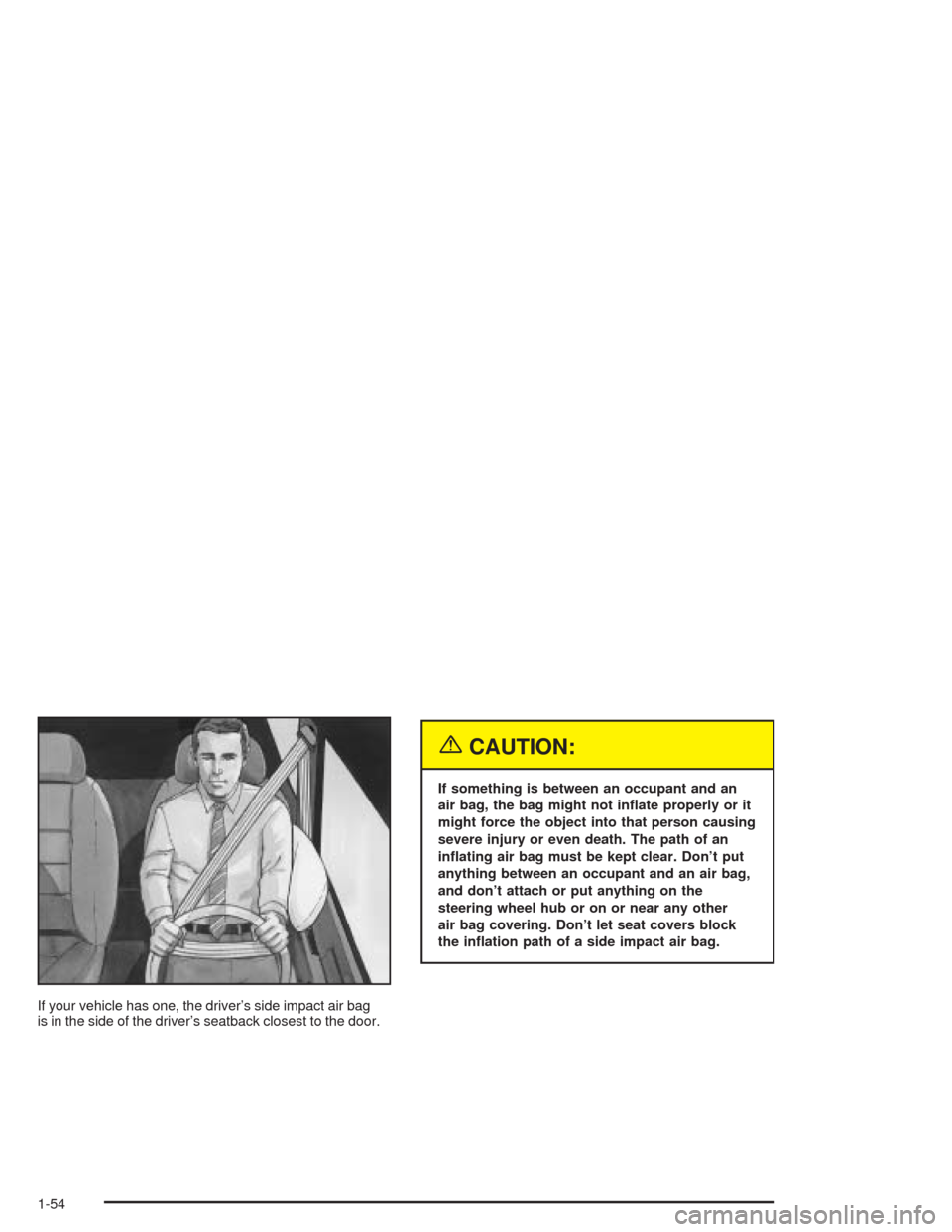
If your vehicle has one, the driver’s side impact air bag
is in the side of the driver’s seatback closest to the door.
{CAUTION:
If something is between an occupant and an
air bag, the bag might not in�ate properly or it
might force the object into that person causing
severe injury or even death. The path of an
in�ating air bag must be kept clear. Don’t put
anything between an occupant and an air bag,
and don’t attach or put anything on the
steering wheel hub or on or near any other
air bag covering. Don’t let seat covers block
the in�ation path of a side impact air bag.
1-54
Page 67 of 334
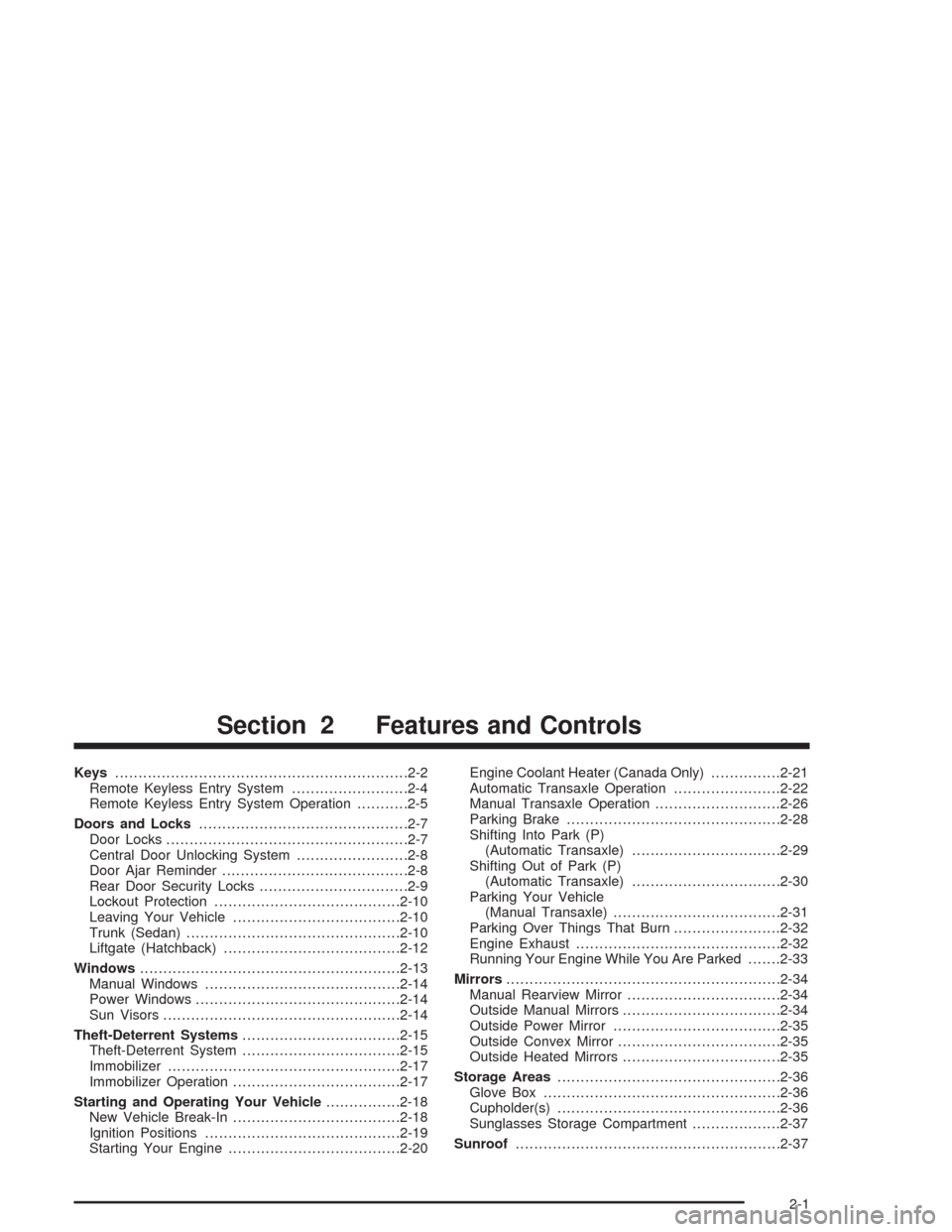
Keys...............................................................2-2
Remote Keyless Entry System.........................2-4
Remote Keyless Entry System Operation...........2-5
Doors and Locks.............................................2-7
Door Locks....................................................2-7
Central Door Unlocking System........................2-8
Door Ajar Reminder........................................2-8
Rear Door Security Locks................................2-9
Lockout Protection........................................2-10
Leaving Your Vehicle....................................2-10
Trunk (Sedan)..............................................2-10
Liftgate (Hatchback)......................................2-12
Windows........................................................2-13
Manual Windows..........................................2-14
Power Windows............................................2-14
Sun Visors...................................................2-14
Theft-Deterrent Systems..................................2-15
Theft-Deterrent System..................................2-15
Immobilizer..................................................2-17
Immobilizer Operation....................................2-17
Starting and Operating Your Vehicle................2-18
New Vehicle Break-In....................................2-18
Ignition Positions..........................................2-19
Starting Your Engine.....................................2-20Engine Coolant Heater (Canada Only)...............2-21
Automatic Transaxle Operation.......................2-22
Manual Transaxle Operation...........................2-26
Parking Brake..............................................2-28
Shifting Into Park (P)
(Automatic Transaxle)................................2-29
Shifting Out of Park (P)
(Automatic Transaxle)................................2-30
Parking Your Vehicle
(Manual Transaxle)....................................2-31
Parking Over Things That Burn.......................2-32
Engine Exhaust............................................2-32
Running Your Engine While You Are Parked.......2-33
Mirrors...........................................................2-34
Manual Rearview Mirror.................................2-34
Outside Manual Mirrors..................................2-34
Outside Power Mirror....................................2-35
Outside Convex Mirror...................................2-35
Outside Heated Mirrors..................................2-35
Storage Areas................................................2-36
Glove Box...................................................2-36
Cupholder(s)................................................2-36
Sunglasses Storage Compartment...................2-37
Sunroof.........................................................2-37
Section 2 Features and Controls
2-1
Page 69 of 334
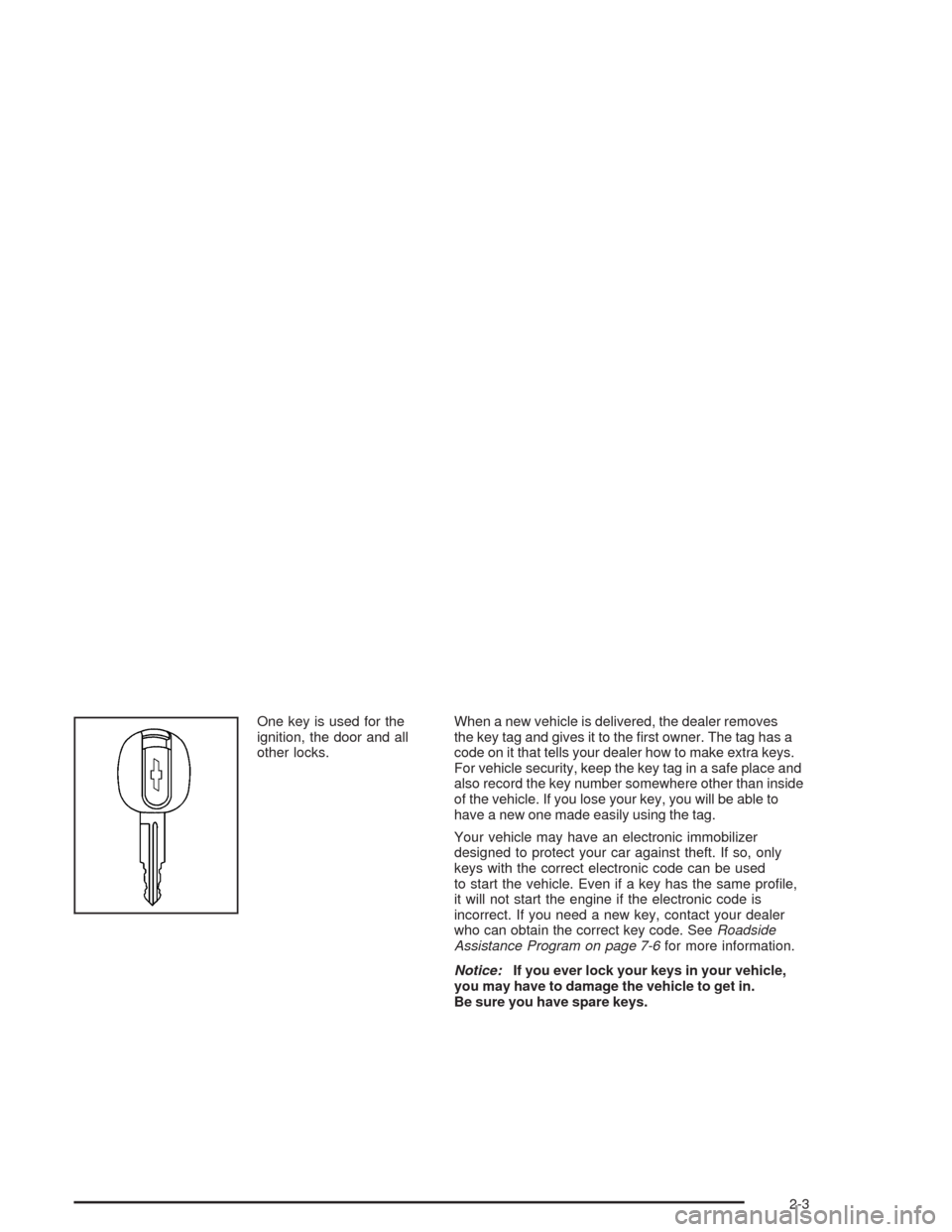
One key is used for the
ignition, the door and all
other locks.When a new vehicle is delivered, the dealer removes
the key tag and gives it to the first owner. The tag has a
code on it that tells your dealer how to make extra keys.
For vehicle security, keep the key tag in a safe place and
also record the key number somewhere other than inside
of the vehicle. If you lose your key, you will be able to
have a new one made easily using the tag.
Your vehicle may have an electronic immobilizer
designed to protect your car against theft. If so, only
keys with the correct electronic code can be used
to start the vehicle. Even if a key has the same profile,
it will not start the engine if the electronic code is
incorrect. If you need a new key, contact your dealer
who can obtain the correct key code. SeeRoadside
Assistance Program on page 7-6for more information.
Notice:If you ever lock your keys in your vehicle,
you may have to damage the vehicle to get in.
Be sure you have spare keys.
2-3
Page 70 of 334
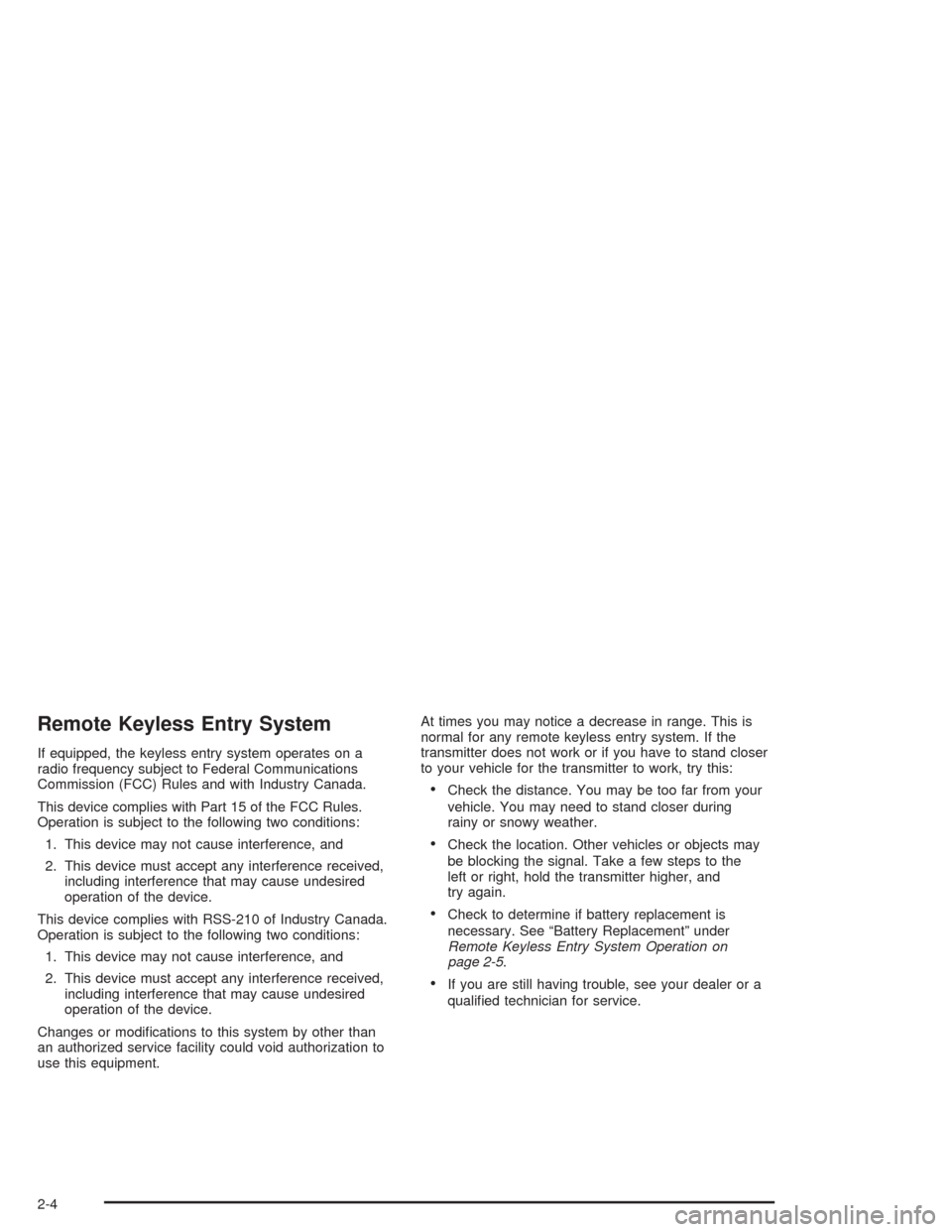
Remote Keyless Entry System
If equipped, the keyless entry system operates on a
radio frequency subject to Federal Communications
Commission (FCC) Rules and with Industry Canada.
This device complies with Part 15 of the FCC Rules.
Operation is subject to the following two conditions:
1. This device may not cause interference, and
2. This device must accept any interference received,
including interference that may cause undesired
operation of the device.
This device complies with RSS-210 of Industry Canada.
Operation is subject to the following two conditions:
1. This device may not cause interference, and
2. This device must accept any interference received,
including interference that may cause undesired
operation of the device.
Changes or modifications to this system by other than
an authorized service facility could void authorization to
use this equipment.At times you may notice a decrease in range. This is
normal for any remote keyless entry system. If the
transmitter does not work or if you have to stand closer
to your vehicle for the transmitter to work, try this:
•Check the distance. You may be too far from your
vehicle. You may need to stand closer during
rainy or snowy weather.
•Check the location. Other vehicles or objects may
be blocking the signal. Take a few steps to the
left or right, hold the transmitter higher, and
try again.
•Check to determine if battery replacement is
necessary. See “Battery Replacement” under
Remote Keyless Entry System Operation on
page 2-5.
•If you are still having trouble, see your dealer or a
qualified technician for service.
2-4
Page 71 of 334
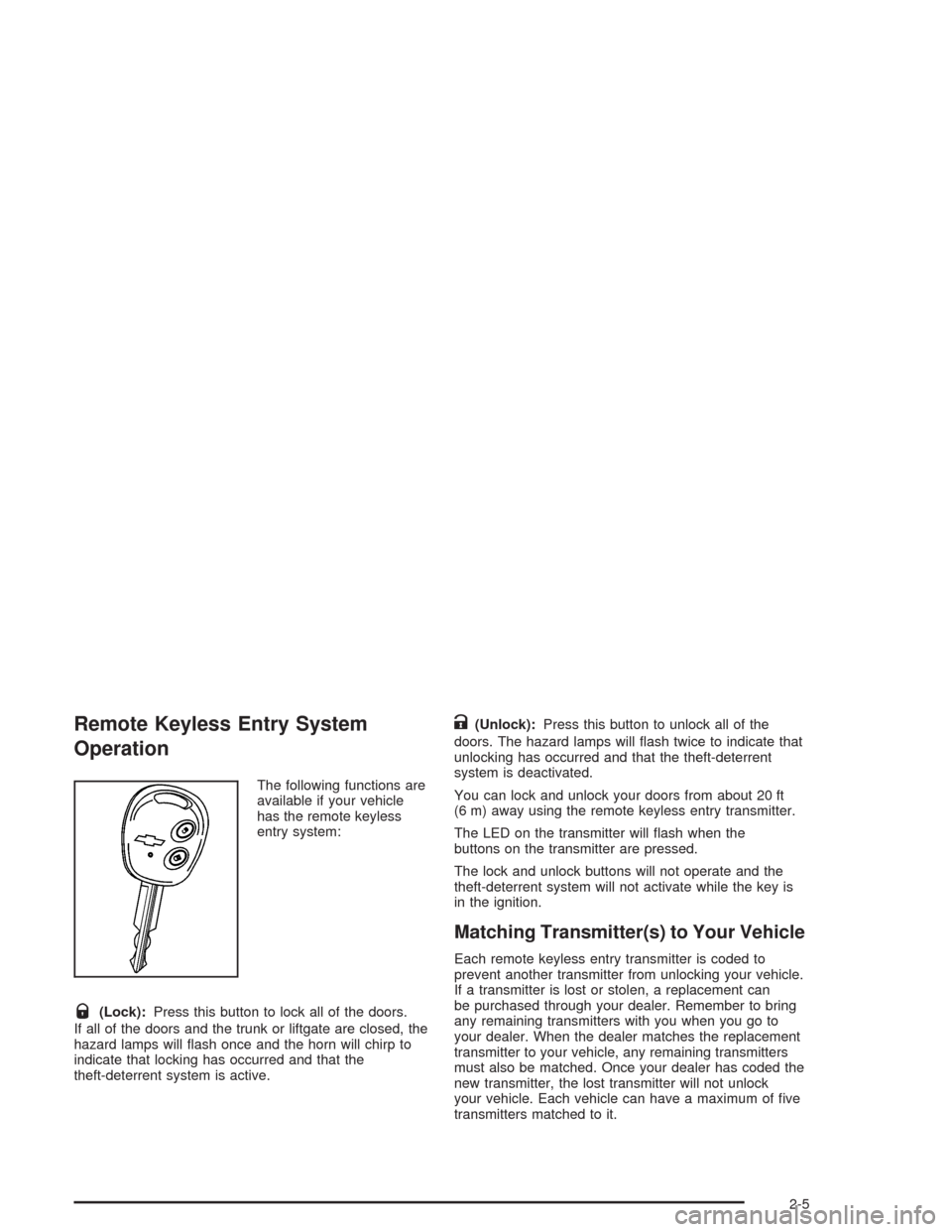
Remote Keyless Entry System
Operation
The following functions are
available if your vehicle
has the remote keyless
entry system:
Q(Lock):Press this button to lock all of the doors.
If all of the doors and the trunk or liftgate are closed, the
hazard lamps will flash once and the horn will chirp to
indicate that locking has occurred and that the
theft-deterrent system is active.
K(Unlock):Press this button to unlock all of the
doors. The hazard lamps will flash twice to indicate that
unlocking has occurred and that the theft-deterrent
system is deactivated.
You can lock and unlock your doors from about 20 ft
(6 m) away using the remote keyless entry transmitter.
The LED on the transmitter will flash when the
buttons on the transmitter are pressed.
The lock and unlock buttons will not operate and the
theft-deterrent system will not activate while the key is
in the ignition.
Matching Transmitter(s) to Your Vehicle
Each remote keyless entry transmitter is coded to
prevent another transmitter from unlocking your vehicle.
If a transmitter is lost or stolen, a replacement can
be purchased through your dealer. Remember to bring
any remaining transmitters with you when you go to
your dealer. When the dealer matches the replacement
transmitter to your vehicle, any remaining transmitters
must also be matched. Once your dealer has coded the
new transmitter, the lost transmitter will not unlock
your vehicle. Each vehicle can have a maximum of five
transmitters matched to it.
2-5
Page 73 of 334
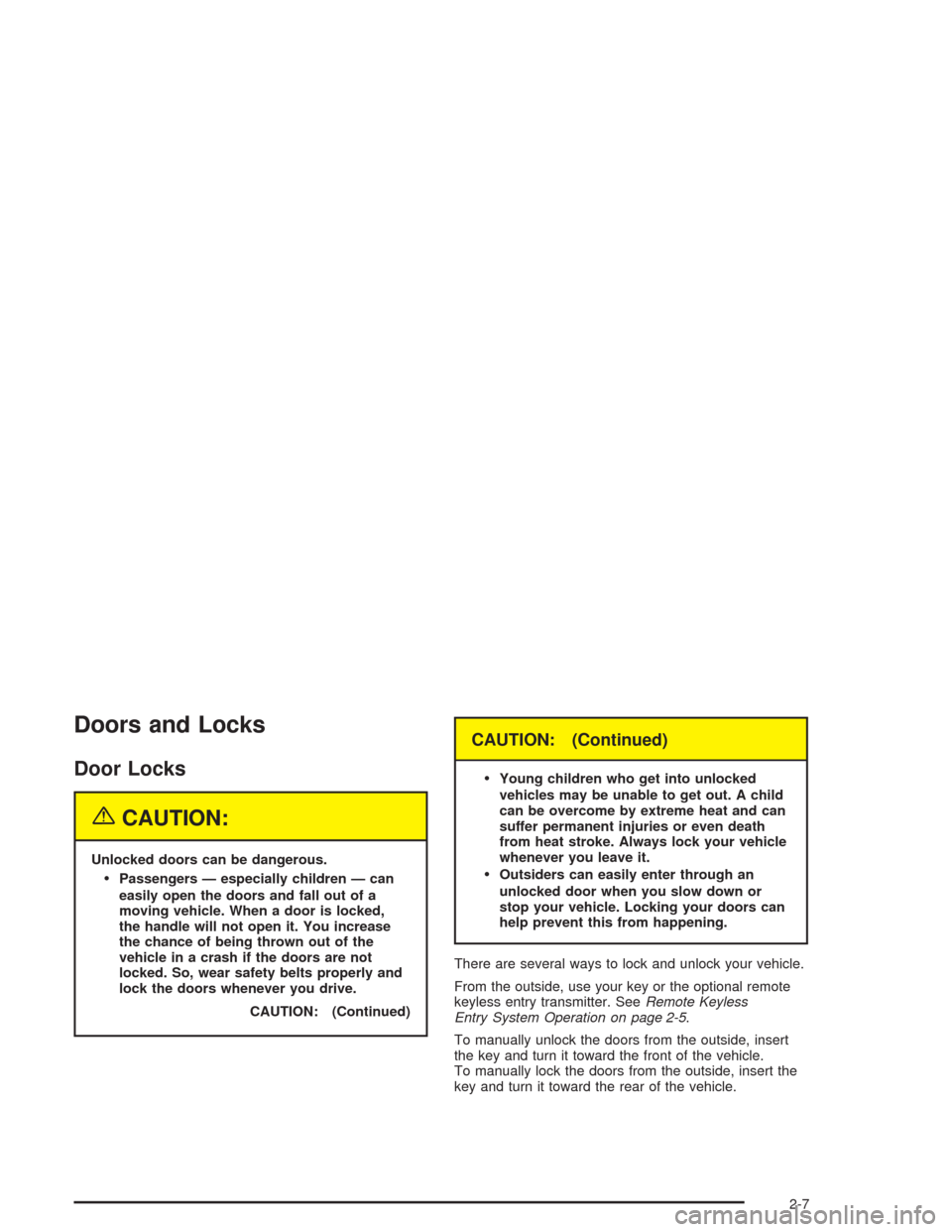
Doors and Locks
Door Locks
{CAUTION:
Unlocked doors can be dangerous.
Passengers — especially children — can
easily open the doors and fall out of a
moving vehicle. When a door is locked,
the handle will not open it. You increase
the chance of being thrown out of the
vehicle in a crash if the doors are not
locked. So, wear safety belts properly and
lock the doors whenever you drive.
CAUTION: (Continued)
CAUTION: (Continued)
Young children who get into unlocked
vehicles may be unable to get out. A child
can be overcome by extreme heat and can
suffer permanent injuries or even death
from heat stroke. Always lock your vehicle
whenever you leave it.
Outsiders can easily enter through an
unlocked door when you slow down or
stop your vehicle. Locking your doors can
help prevent this from happening.
There are several ways to lock and unlock your vehicle.
From the outside, use your key or the optional remote
keyless entry transmitter. SeeRemote Keyless
Entry System Operation on page 2-5.
To manually unlock the doors from the outside, insert
the key and turn it toward the front of the vehicle.
To manually lock the doors from the outside, insert the
key and turn it toward the rear of the vehicle.
2-7
Page 74 of 334
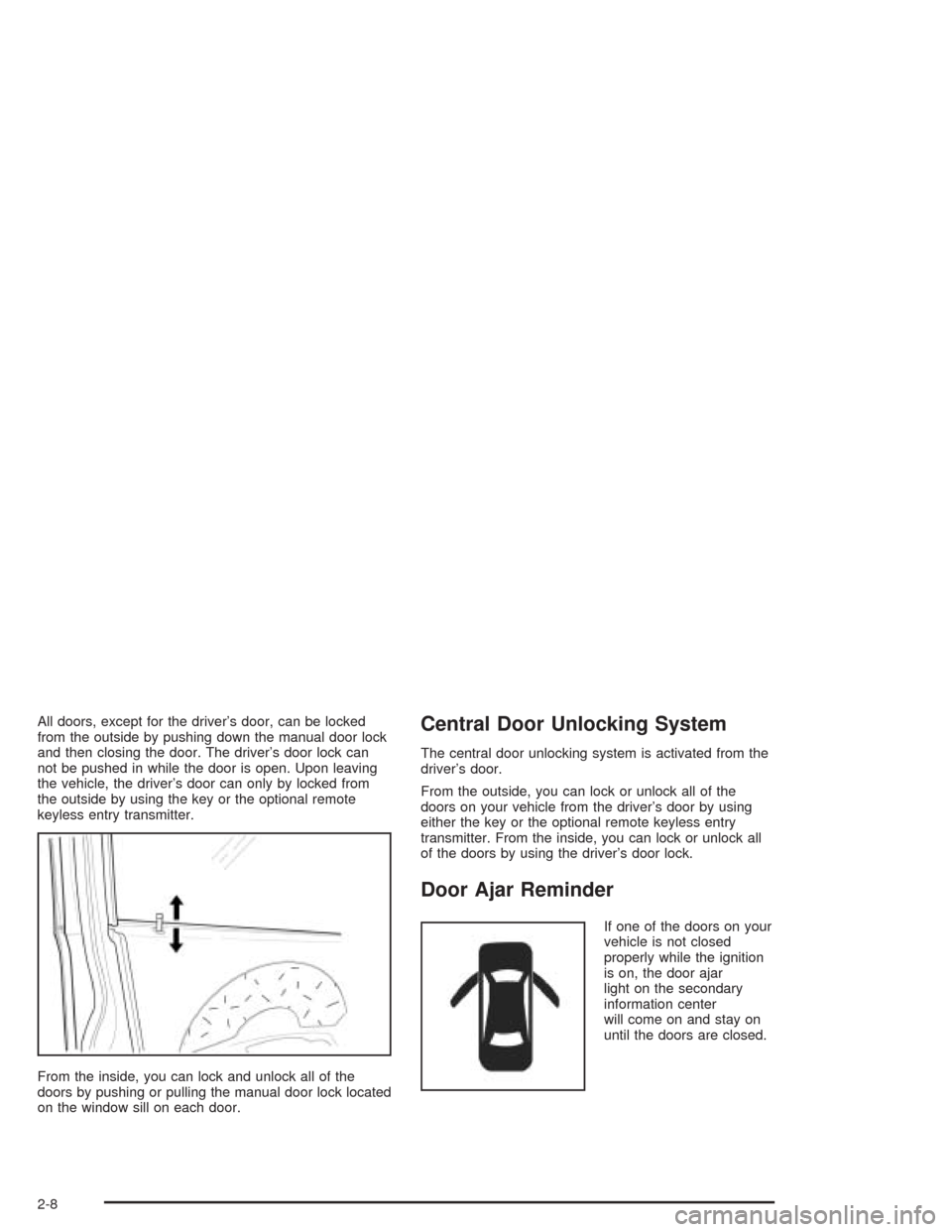
All doors, except for the driver’s door, can be locked
from the outside by pushing down the manual door lock
and then closing the door. The driver’s door lock can
not be pushed in while the door is open. Upon leaving
the vehicle, the driver’s door can only by locked from
the outside by using the key or the optional remote
keyless entry transmitter.
From the inside, you can lock and unlock all of the
doors by pushing or pulling the manual door lock located
on the window sill on each door.Central Door Unlocking System
The central door unlocking system is activated from the
driver’s door.
From the outside, you can lock or unlock all of the
doors on your vehicle from the driver’s door by using
either the key or the optional remote keyless entry
transmitter. From the inside, you can lock or unlock all
of the doors by using the driver’s door lock.
Door Ajar Reminder
If one of the doors on your
vehicle is not closed
properly while the ignition
is on, the door ajar
light on the secondary
information center
will come on and stay on
until the doors are closed.
2-8